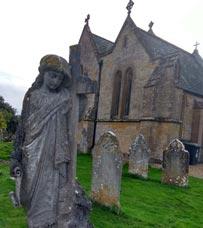
8 minute read
Down to Earth
BEACHCOMBING with JO BELASCO BA Hons History of Architecture and Design
On some Dorset beaches many vintage doll parts can be found. They were once sold as bath toys, which children down the ages liked to take to the beach as well. Long have I been looking forward to doing a Halloween extravaganza on this subject. Only one problem – so far I have only found one little torso. I kept looking right up to the last moment so yes, I know Halloween is over but bear with me... it’s nearly another full moon. I just had to put my thinking cap on and imagine a little harder. This tiny torso was probably made in the late 19th century – you can see the little holes which would have had separate arms and legs fitted into them. As I have not unearthed any limbs yet I let my mind wander to The Flintstones and created a variation on their car using cotton buds for axels and clay beads for wheels left from a previous article. Bizarre it is – yet not quite Halloween-level scary. As well as looking like a chassis the turbo torso reminded me of a pie funnel. My mum used to have one in the shape of a blackbird to let the steam out of pies she made. Of course she didn’t make blackbird pies any more than I made a torso pastry. Jellyfish are scary too and plentiful in our seas – in fact in every ocean. They’re hotly forecast to be part of our diet by 2050 and already on many British menus. A word of warning though – they need to be cleaned and prepared by an expert so please don’t try to eat them as they all have a sting of various intensity and only some are edible even after the sting has gone. I have only found beached jellyfish, as diving is not my thing. But I can still appreciate the creatures’ otherworldly allure. The first photo shows the marvellously coloured blue jellyfish. This second is a compass type. The delicate markings which decorate its body remind me of a sailor’s tattoo.
Advertisement
JELLY VISION: Top left, a blue jellyfish and, right, a compass jellyfish. Why a beach body really looks like a torso, only more so
The West Dorset Magazine, November 4, 2022 47 Down to earth A warm welcome to visiting birds this winter
Sally Cooke lives in Tolpuddle with her husband, two grown up sons and her spotty rescue dog. You can follow Sally on Instagram at Sparrows in a Puddle
The clocks have gone back and we’ve moved into increasingly cooler days and frustratingly longer evenings. Some of my friends have been following the swallow’s example and have headed south to try and squeeze out the last little bit of summer. But I’m here and coping with ‘No dawn, No dusk, No proper time of day, No warmth, No cheerfulness…November’. But as Thomas Hood wrote his dreary poem long before central heating, electricity and box sets on demand, I’m much better placed to cope with my 12th favourite month and in nature there is plenty going on to keep me happy! Although it is the summer swallows that spring to mind when we think of migration, our relatively mild winter weather attracts huge numbers of visiting birds each winter, and they’re arriving now. One such visitor is the starling. Although we have starlings resident all year round, I have noticed much greater numbers in the village than over the summer. Thousands of starlings have been reported heading over the North Sea from Europe in recent weeks and joining our resident birds.The starlings roost together, sometimes in huge numbers and their spectacular winter displays or ‘murmurations’ at dusk before they settle down for the night are wonderful to watch. Other winter visitors that I’m excited to see return in November are the redwings and fieldfares. These beautiful thrushes migrate from their breeding grounds in Scandinavia to feast on our plentiful fruits and berries. The smaller redwing has a distinctive pale eye stripe and as its name suggests, red patches under its wings, while the larger fieldfare has a grey head and rump, and brown wings. Both birds are very social and will often feed together in large mixed flocks in the fields near me. I love hearing the fieldfare’s chuckling ‘chack chack chack’ when they fly. There is one winter visitor that I have only seen in the village once, though I’m always hoping, and that is the exotic-looking waxwing. A small group of them came and stripped a cotoneaster bush of all its berries a few years ago, causing me great excitement and encouraging several birders with their cameras to the village. If their food supplies are low in Scandinavia and Russia, great numbers of waxwings may migrate to the UK. Will this year be a ‘waxwing winter’? We’ll have to wait and see.
What a difference a drey makes to a squirrel
JOHN WRIGHT is a naturalist and forager who lives in rural West Dorset. He has written eight books, four of which were for River Cottage. He wrote the awardwinning Forager’s Calendar and in 2021 his Spotter’s Guide to Countryside Mysteries was published.
With the leaves progressively abandoning their lofty situation, we can again see the several lumpy, bushy and spikey constructions that have been largely hidden from our view during the warmer months. These could be bird’s nests, cankers, burrs –such as the impressive Witch’s broom, or squirrel dreys. Famously, we have both the grey and the red in residence in Dorset, albeit with the red squirrels confined in glorious isolation on Brownsea Island. While the two species do not get on at all, their dreys are similar and much of my description below applies to both. Squirrel dreys are substantial affairs, almost invariably high up and typically up to 30 cm in diameter. In fact, these dreys are the largest of three types, the winter drey, and may well be of recent manufacture, as is somtimes evidenced by the presence of relatively fresh leaves poking from the sides. The other two are the summer drey, a simple platform for al fresco sleeping, and the natal drey, a half-way-house between the other two and, obviously, used for the nurturing of the young. There are also ‘cavity dreys’, also known as ‘dens’, opportunistically built inside holes in trees As mentioned, winter dreys may be recent, but they may, with a bit of annual DIY, last for years. Sometimes, they can even be passed on to later generations who that grab the chance of not facing a new-build. While dreys look like a pile of sticks held together and in precarious position only by a pair of miracles, they are complex and built with care. A simple platform is laid down (or an abandoned bird’s nests commandeered for the purpose), then carefully chosen twigs are positioned, also with care, until the exterior is mostly complete. The chamber is then, effectively, burrowed-out of the pile of twigs. The chamber is then lined with anything up to thirty layers of leaves, all arranged like shingles to keep the rain out. This may be dry, but will also be very cold, so a final layer is added inside consisting of any or all of dried grass, moss, fur, feathers and wool. With the eco-friendly insulation in place, a temperature of twenty-five degrees or more can be maintained, even in the coldest winters. While this cosy bedroom seems like a five star place to hibernate, squirrels are active all year round and use their dreys only to sleep and rest.
PAGAN VIEWS by JO BELASCO
By the end of the day I would be friends with a polar explorer. The spire of the local church rose above the skyline temptingly. Having 20 minutes to spare until my next appointment, I wandered over to Holy Trinity Church. To be honest I was planning on a snooze in the car but as I walked along I noticed the raised walkway which carves round in Bradpole and it jogged memories of recent dreams. From the graveyard I could see a prehistoric barrow mound just across the way. I had read the original church was rebuilt on different ground in Victorian times. Would the inside of the church give much away? And so I walked in. Ah yes, I thought, nearly all 19th century, can’t see many older parts (apart from the font), beautiful stained glass windows and nice angel mural. Before I leave I always have a gander at the visitors’ book and make my mark. The last comment was: “A lovely church, full of secrets” – EC Coleman. Well, that was like a red rag to a bull. I wrote in the visitors’ book: “I wish I had met EC Coleman to show me the secrets.” And I did wish this but all was not lost… I noticed he or she had left an email address. E C Coleman? Now was that 12-year-old Elizabeth Caroline who had dotted ‘kindness rocks’ around for others to find? No, turns out it was 78-year-old Ernest Coleman – polar explorer! But what was EC Coleman doing at Holy Trinity church and more to the point, what were these secrets he mentions? I can’t say all was revealed after a series of emails between us but some was. Turns out Bradpole church has been the scene of some rather diabolical doings in the past. EC Coleman is writing a whole book about the shenanigans. As the book is “tied up with the publisher” at the moment he can’t give much away but he has published nine other books – some of them history and some adventure (I am talking polar exploring, not my level of adventure which let’s face it is foraging in prickly bushes) I am on tenterhooks waiting to hear the whole story.

COLEMAN’S MUSTARD: EC Coleman’s entry in the visitors’ book and, below, the ancient barrow in the distance seen from Holy Trinity church which is a scheduled monument and, right, the weeping angel in the churchyard Going to ends of the earth to explore churchyard’s secrets







